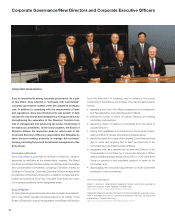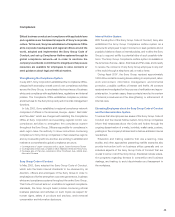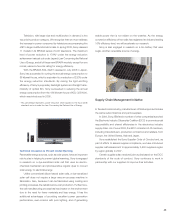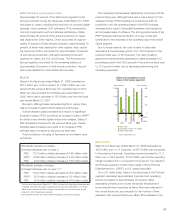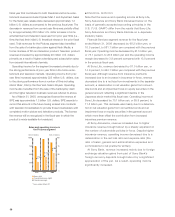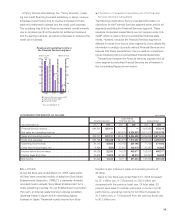Sony 2008 Annual Report Download - page 51
Download and view the complete annual report
Please find page 51 of the 2008 Sony annual report below. You can navigate through the pages in the report by either clicking on the pages listed below, or by using the keyword search tool below to find specific information within the annual report. 49
TREND INFORMATION
This section contains forward-looking statements about the
possible future performance of Sony and should be read in light
of the cautionary statement on that subject, which appears on
the inside back cover page and applies to this entire document.
ISSUES FACING SONY AND MANAGEMENT’S RESPONSE
TO THOSE ISSUES
Below is a description of the issues management believes each
segment continues to face and an explanation as to how each
segment is approaching those issues.
■ ELECTRONICS
Although the Electronics segment continues to hold a very
strong position in the worldwide consumer audio visual products
market, that position has become increasingly threatened as a
result of the entrance of new manufacturers and distributors.
These new entrants are threatening Sony’s position due to the
industry shift from analog to digital technology. In the analog era,
complicated functionality of electronics products was made
possible through the combination of several complex parts, and
Sony held a competitive advantage in the design and manufac-
ture of those parts as a result of its accumulated expertise. In
the digital era, however, complicated functionality has become
concentrated in semiconductors and other key digital devices.
Since these semiconductors and key devices can be mass
produced, they have become readily available to new market
entrants, and the functionality that once commanded a high
premium has become more affordable. This has led to intense
price erosion in the consumer audio visual products market.
Also, Sony is exposed to the pressure of declines in selling
prices as a result of a concentration of market share among a
limited number of dealers and retailers. To respond to these
challenges, Sony is striving to keep pace with price erosion by
reducing its manufacturing and other costs. It is seeking to
maintain the premium pricing it enjoys on many of its end-user
products by adding functionality to those products and develop-
ing new applications and uses that appeal to the consumer. In
addition, it is taking steps to increase its competitive edge by
developing high value-added semiconductors and other key
digital devices in-house.
Sony considers improving the profitability of the television
business, which recorded a loss in the fiscal year ended March
31, 2008, as the most pressing issue facing the Electronics
segment. As such during the fiscal year ended March 31, 2008,
Sony decided to exit the cathode ray tube (“CRT”) television and
LCD rear-projection television businesses due to the shrinking
market for these products, and concentrate management
resources on the LCD television business. In order to improve
profitability in the LCD television business, Sony will continue
cost reduction plans through the standardization of panels and
chassis and the reduction in the number of components used
in production. In addition, Sony is targeting unit sales growth
exceeding that of the market by continuing to focus on large-
size and high value-added models, while at the same time
expanding the line-up of lower priced models and actively
developing emerging markets.
In anticipation of an increase in unit sales of LCD televisions,
Sony recognizes the importance of a stable supply of LCD
panels. S-LCD Corporation (“S-LCD”), Sony’s joint venture with
Samsung Electronics Co., Ltd. (“Samsung”), which is based in
South Korea, started its 7th generation amorphous thin-film
transistor (“TFT”) LCD panel production line operation in April
2005 and has a current production capacity of 120,000 sub-
strates of mother glass per month. S-LCD also started its 8th
generation amorphous TFT LCD panel production line opera-
tion in August 2007 and has a current production capacity of
50,000 substrates per month. Furthermore, S-LCD plans to
construct a new 8th generation LCD panel production line and
start production during the second quarter of calendar year
2009 with an initial production capacity of 60,000 substrates
per month. Also, Sony, together with Sharp Corporation
(“Sharp”), signed a non-binding memorandum of intent in
February 2008 to establish a joint venture to manufacture
amorphous TFT LCD panels and modules on a 10th generation
production line. Sony and Sharp aim to enter into legally bind-
ing joint venture documentation by September 30, 2008.
Production capacity is planned to be 72,000 substrates per
month. Sony plans to receive a supply of 50 percent of the LCD
panels produced by S-LCD and 34 percent of the LCD panels
produced by the joint venture with Sharp.
Sony has reviewed its investment policy in the semiconductor
business. In the future, Sony will carefully select investments
and adopt a strategy to more clearly focus on the charge-
coupled devices (“CCDs”) and complementary metal oxide
semiconductor (“CMOS”) image sensors and television- and
video-related businesses. As part of this strategy, in March
2008, Sony sold to Toshiba Corporation (“Toshiba”) production
equipment for high- performance semiconductors such as the
“Cell Broadband Engine™” processor and the RSX™ graphics
engine for PLAYSTATION®3 (“PS3”), installed in the Nagasaki
Technology Center of Sony Semiconductor Kyushu
Corporation. Nagasaki Semiconductor Manufacturing
Corporation was established by Toshiba, Sony and Sony
Computer Entertainment and commenced operations on
Operating and Financial Review
Sony Corporation and Consolidated Subsidiaries



